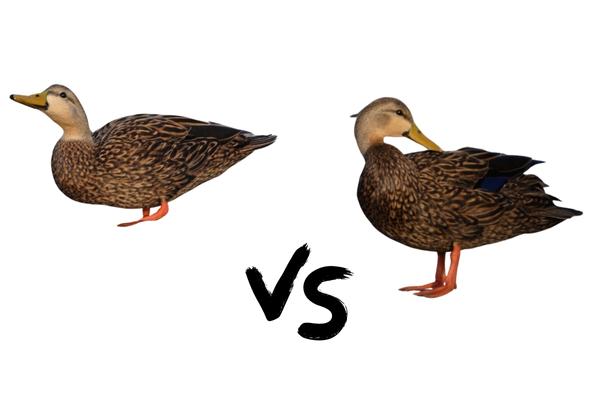All about Birds
A Comprehensive Guide to the Different Types of Florida Ducks
When it comes to the birds that inhabit Florida, ducks are often a favorite amongst nature lovers. These waterfowl species can be found in many habitats throughout the state and come in a variety of shapes and sizes.
Florida ducks not only provide awe-inspiring visuals but also offer valuable insight into the environment due to their unique biology. Understanding the different types of Florida ducks is essential for anyone looking to appreciate and protect these feathered friends.
The Different Types of Ducks You Can Find in Florida
1. Green-Winged Teal
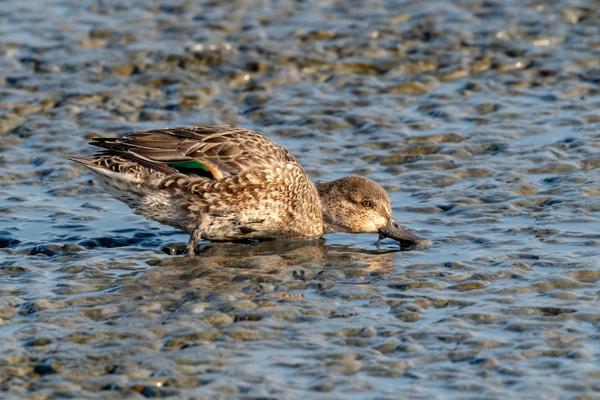
Florida is home to many different species of ducks, including the green-winged teal. These ducks are relatively small, with brown feathers and a green head. The males also have a distinctive dark crescent on their wings.
Green-winged teal is often found near freshwater marshes and ponds, where they feed on insects and aquatic plants. In Florida, they are most common in the northern and central parts of the state. These ducks are shy and typically stay in small flocks.
However, they can sometimes be seen mingling with other types of ducks, such as blue-winged teal or mallards. Florida’s wetlands provide critical habitat for many different kinds of wildlife, including the green-winged teal. By protecting these habitats, we can help ensure that Florida’s ducks will continue to thrive for years to come.
2. Surf Scoter
Surf Scoters are Florida ducks that can often be seen swimming in the ocean, bobbing on the waves. They have black feathers and white patches on their wings, and they are excellent swimmers.
These ducks can often be seen chasing after fish, which they capture with their long, sharp beaks. Surf Scoters are interesting Florida ducks because they spend most of their time in the ocean rather than on land. When they do come ashore, it is usually only to nest.
These Florida ducks are interesting and unique creatures that make a great addition to any nature lover’s list of animals to observe.
3. Blue-Winged Teal
The blue-winged teal is a common duck found in Florida. These ducks have white and gray body feathers, with distinctive blue wings. The males also have a green head and a white crescent on their wings.
Blue-winged teals are often seen in wetland habitats, where they feed on aquatic plants and insects. They typically nest close to water and in marshy vegetation.
Like most ducks, blue-winged teals migrate long distances when their breeding grounds become flooded or frozen over. In Florida, they can be found during the winter months, when they come down from the north to escape cold temperatures.
Blue-winged teals are relatively small ducks, typically ranging between 10 and 13 inches in length. They are also one of the fastest flying waterfowl, capable of reaching speeds of up to 60 miles per hour!
These ducks form tight flocks with other species such as mallards and wood ducks. Male blue-winged teals are known to be very aggressive during the breeding season and will often fight with other males over territory. Blue-winged teals are also very vocal, producing loud calls that can be heard up to a mile away.
Blue-winged teals are an important food source for many predators in Florida, including hawks, owls, raccoons, and even alligators. These ducks are also a popular species for hunters, who often hunt them in the winter months when their population peaks. Blue-winged teals play an important role in Florida’s ecosystems and provide many benefits to humans and wildlife alike.
4. Mallard Ducks
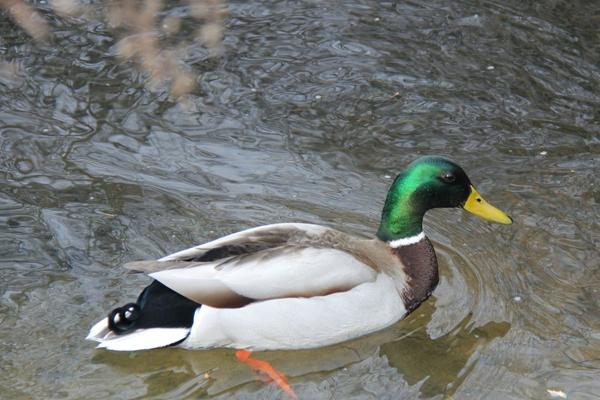
Mallard ducks are one of the most popular and familiar waterfowl in Florida. With its bright green head, rusty red breast and white neck ring, this species is easily distinguishable from other ducks. Mallards can be found year-round in wetlands, lakes, ponds and other aquatic habitats throughout the state.
These ducks are omnivorous and feed on a variety of aquatic plants, grains, insects, mollusks, fish and other small animals. Mallards often nest in wetlands near vegetation which provides cover from predators. During the summer months they can be seen swimming with their young on the surface of Florida’s lakes and ponds.
Mallards are social birds, often seen in large flocks. In the winter months, these flocks can become quite large with thousands of individuals. They are also among the most sought after game birds for hunters in Florida.
5. Wood Duck
The Wood Duck is a medium-sized perching duck with eye-catching coloration and distinct features. It has iridescent feathers in shades of green, purple, blue, red, and yellow with white markings on its wings. The male Wood Duck has a bright red bill, with a black ‘crown’ on the back of its head. The female is smaller, with a grey bill and a white ring around its eyes.
Wood Ducks are found throughout wetlands in Florida, including lakes, marshes, rivers, swamps, ponds and bogs. They feed on small aquatic insects and plants such as acorns and beechnuts. Wood Ducks prefer to nest in tree cavities and will also use artificial nesting boxes. In the winter, they may move to larger bodies of water where food is more abundant.
Wood Ducks are not as vocal as other ducks but they do make a variety of sounds – cooing, chirping, quacking, and whistling. They are generally quite sociable and can often be seen in pairs or large flocks. They are also quite agile, capable of flying in tight spaces and dodging obstacles.
Wood Ducks are quite beautiful birds that make excellent additions to any backyard flock. They are relatively easy to care for and will provide years of joy and entertainment with their vibrant colors and friendly personalities.
7. Canvasb ack – Aythya valisineria
The Canvasback is a species of duck found in the wetlands and marshes of Florida. It is one of the most sought-after waterfowl by hunters in the state due to its attractive plumage and relatively easy access within hunting grounds.
Canvasbacks are medium-sized ducks, measuring around 20 inches long with a wingspan of 33 inches. They are easily recognizable by their sloping forehead, with the back of its head being white and the front a light brown or gray color. The rest of its body is blackish-brown with a white chest and tail. Males have a bright red eyes while females have more dull colored eyes.
Canvasbacks typically feed in shallow waters, eating a variety of aquatic vegetation such as water lilies and pondweed. They also eat small invertebrates like snails, mussels, and insects. During the summer months they can be seen flying higher in the sky than other ducks, often circling before landing.
In Florida, Canvasbacks nest from late April to early May. The female will build a shallow nest on the ground near water, usually lined with grass and other vegetation. The male will stay nearby to provide protection for the nesting pair until their young hatch.
Canvasbacks are protected by both federal and state laws, however they are still hunted during certain seasons. The hunting season usually runs from mid-September to mid-December, and the bag limit is three birds per day.
8. American Black Duck
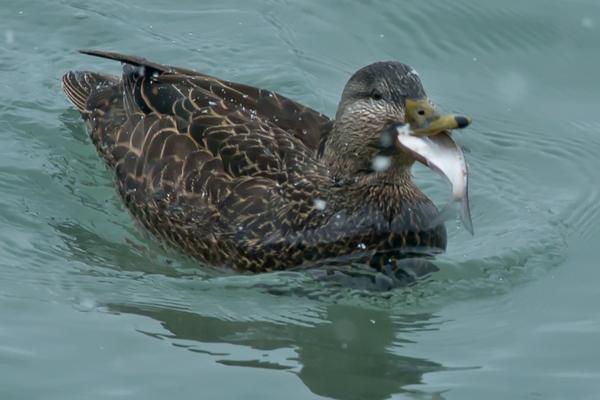
The American Black Duck is a species of dabbling duck found in much of North America. It is also known as the black mallard, due to its similar coloration. The black duck is mostly dark brown with a greenish sheen on the head and neck, and sometimes on the breast. It has yellow legs and feet, and a dark orange bill. It is closely related to the mallard and together, they form the subgenus Anas.
The American Black Duck breeds in eastern North America from Nova Scotia to Florida, and westwards to Minnesota and Texas. It winters along much of the Atlantic coast, as well as further inland in large river systems like the Mississippi. It is an adaptable bird and can be found in a wide range of habitats, including wetlands, rivers, lakes, marshes and wet meadows.
The American Black Duck feeds on a variety of aquatic plants as well as insects, crustaceans and mollusks. It often dives to the bottom of shallow water bodies to feed. It is commonly seen in large flocks, though it often pairs up when breeding. The female builds the nest in secluded areas on the edge of water bodies and lays between five to twelve eggs per clutch.
The American Black Duck is listed as a species of least concern by the IUCN due to its wide distribution range and relatively large population. It is an important species for waterfowl hunting, and its population has been affected by the hunting pressure in some areas. Conservation efforts are ongoing to ensure its continued survival.
9. Redhead Ducks
The Redhead is a large diving duck, similar in size to their cousins the Canvasback. The male Redhead ducks have a dark chestnut head with a blue bill, black neck and back, yellow eyes and white sides.
The female has an overall mottled brown body coloration, with some buff and gray feathering on the back, face and sides. They are most easily spotted in coastal areas during fall and winter months, although they may be seen further inland if there is enough water for them to feed.
Redhead ducks primarily eat aquatic vegetation, but they will also feed on insects, crustaceans and mollusks. During the summer breeding season, they breed in freshwater marshes and ponds. The males perform courtship displays to the females which involve a series of head-shaking movements and diving. The female will typically lay between 8 and 10 eggs in a nest made out of vegetation at the edge of water.
Redheads are very social ducks that may be seen in large flocks of up to several hundred individuals. They are a migratory species and will fly south for the winter. During their migration, these ducks may stop in Florida for a few months before continuing on their way down to Mexico or Central America. The Redhead is an important species for recreational hunters in North America due to its abundance and size.
10. Wrapping up
Florida ducks are one of the most interesting birds in the state. They have a wide variety of natural habitats, from lakes and ponds to marshes and wetlands.
These ducks play an important role in the ecosystem, providing food for many other creatures such as fish, turtles, wading birds, and even alligators! The interactions among Florida’s ducks, habitats, and other wildlife are fascinating to observe, making them a great topic for bird-watching. Not only this, but they provide aesthetic value to the environment as their bright plumage makes them stand out in outdoor settings.
All in all, Florida’s myriad of duck species makes it an ideal state to observe these wonderful birds. With a little bit of knowledge and planning, you can easily find your own flock to appreciate and enjoy. So grab your binoculars and get out there! You never know what surprises await you when exploring the wetlands in Florida.
11. Mottled Duck
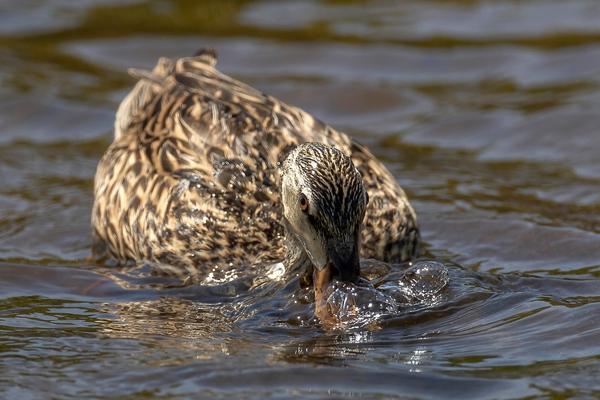
The Florida mottled duck is a subspecies of the mottled duck that is endemic to Florida. It is one of the Florida ducks that have been categorized as a game bird. The Florida mottled duck is further divided into two subtypes: the Florida everglades mottled duck and the Florida peninsula mottled duck.
The Florida everglades mottled duck inhabits the southern part of Florida including the Everglades, while the Florida peninsula mottled duck resides in the northern and central parts of Florida. Among the different types of Florida ducks, the Florida mottled duck is the only one that breeds in freshwater marshes.
Mature male Florida mottled ducks have dark brown heads with a white ring around their necks. Their chests and bellies are white while their wings and backs are dark brown with white spots. Female Florida mottled ducks are much less colorful, with dull brown plumage. Both sexes have yellow eyes and webbed feet.
Florida mottled ducks typically eat aquatic plants and animals such as small fish, crustaceans, and insects. They forage by tipping forward in the water and using their bills to filter food from the bottom of ponds or rivers. Florida mottled ducks breed from March to June.
The female lays a clutch of 6-12 eggs which she incubates for 25-28 days. The chicks fledge at 45-50 days old but they remain with their parents until they are ready to breed themselves, typically at 1-2 years old.
Although they are not considered an endangered species, Florida mottled ducks face threats from habitat loss and degradation due to human activity such as development, agriculture, and pollution.
12. White-Winged Scoter
The white-winged scoter is a large sea duck that breeds in Florida. The males are black with a white wing patch, while the females are brown with a dark-colored head. Both sexes have yellow eyes and orange bills. The white-winged scoter feeds on mollusks, crustaceans, and small fish.
It is often seen swimming in Florida bay or along the Gulf Coast. In winter, the white-winged scoter can be found along the Atlantic and Pacific coasts, as well as in the Great Lakes region.
This duck is not currently considered to be at risk for extinction. However, its populations have declined in recent years due to habitat loss and hunting pressure. As a result, the white-winged scoter is now protected by the Migratory Bird Treaty Act.
13. Ring-necked Duck
The Ring-necked Duck is a waterfowl species native to Florida and much of North America. The species can be identified by its black head, white ring around the neck, and blue bill. They are smaller than most ducks, measuring 16-18 inches long with an average weight of 1.5 pounds. They have a brownish back, mottled flanks, and a darker chest.
Ring-necked Ducks are highly social and prefer to live in larger groups or congregate along with other waterfowl species. They inhabit freshwater wetlands, lakes, ponds, rivers, and estuaries across the state of Florida. In terms of diet, they eat mostly aquatic invertebrates, such as snails, clams, and insect larvae. They also consume plant material including seeds and grains.
In terms of reproduction, Ring-necked Ducks often mate for life and will usually return to the same area each year to breed. The female ducks lay 5-10 eggs in a shallow depression lined with grass and down feathers. The eggs will be incubated for approximately 24-30 days before hatching. After hatching, the young ducks will stay close to their parents until they reach adulthood at around 8 weeks old.
Ring-necked Ducks are a popular game species in Florida and are sought out by both recreational and commercial hunters. The harvest season runs from September to February and the maximum bag limit is 7 birds per day.
14. Hooded Merganser
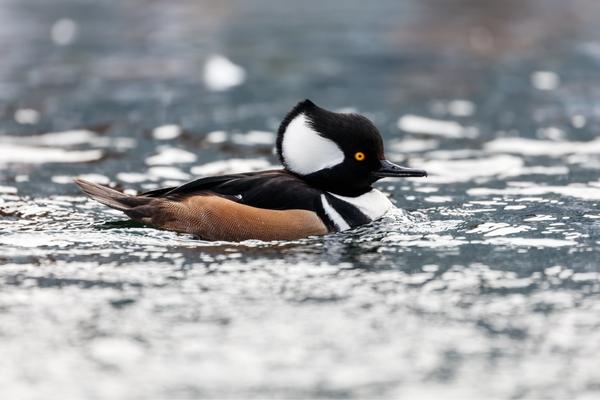
The hooded merganser (Lophodytes cucullatus) is a small duck of the northern hemisphere. It breeds in North America and Eurasia, where it typically winters along rivers, lakes, streams and marshes.
The species has a black-and-white patterned top with a bright red bill and white throat patch. Its head is also adorned with a crest of feathers that are black and white, giving it its name. In the southernmost parts of Florida, Hooded Mergansers can be spotted during their migratory season which runs from October to April.
Hooded Mergansers feed mainly on aquatic invertebrates such as crayfish, aquatic insects, and small fish. They are also known to eat frogs, tadpoles and salamanders. These ducks forage by diving or dabbling in the water, often propelling themselves forward with their feet and heads bobbing above the surface.
Hooded Mergansers can be found in wooded wetlands with plenty of vegetation near large bodies of water. They nest in cavities and nest boxes, often with the help of a wood duck hen for assistance. The female typically lays up to twelve eggs which she incubates for about 27 days until hatching.
In addition to their bright plumage and unique crest, Hooded Mergansers also possess an impressive courtship display. The male will spread its wings and emit a loud, vibrating call while simultaneously shaking its head back and forth to show off its crest feathers. This behavior is typically done in an effort to attract a female mate.
15. Ruddy Duck
The Ruddy Duck, also known as Oxyura jamaicensis, is a small species of duck native to the Americas. It has a distinctive russet body and white cheeks, making it an easily recognizable bird in the wetlands of Florida. The Ruddy Duck breeds primarily in freshwater ponds, marshes and lakes but can be found in coastal areas during the winter.
The Ruddy Duck is a very vocal bird, with a loud quacking call that can be heard across the wetland habitats it frequents. It has an impressive mating ritual involving a type of head-bobbing and splashing display which male ducks use to attract females. The nesting season lasts from April to June with pairs building a nest out of vegetation, feathers and mud close to the water’s edge.
The Ruddy Duck is an omnivore, eating insects, small fish, crustaceans and plant material. Due to its relatively small size, it must take advantage of low-hanging fruits from trees or floating algae mats in order to survive.
The Ruddy Duck is an important species in Florida, helping to preserve the balance of aquatic ecosystems by controlling insect and fish populations. It also serves as prey for predators such as birds of prey and large fish, adding another layer of complexity to the wetlands it inhabits.
16. Long-tailed Duck
The Long-tailed Duck (Clangula hyemalis) is a migratory species that visits Florida in the winter. These ducks are among the smallest sea ducks, with adults measuring between 15 and 20 inches long.
The male has a black head and neck, white spots across its back, and a distinctive long tail. Females are plainer, with a dark brown head and neck, gray back, and white spots.
Long-tailed Ducks are found along the coasts of Florida in the winter months. They feed on crustaceans, mollusks, insects, and small fish. During breeding season they breed in freshwater ponds and marshes throughout the northern United States and Canada.
Long-tailed Ducks typically rest and feed near the surface of the water, but they can also dive underwater to catch prey. If startled, these ducks will take off quickly in flight. They are strong fliers, covering long distances during their migration south each year.
17. Bufflehead

The Bufflehead is another sea duck that makes Florida its home. It’s the smallest of all diving ducks, with a black and white “buffalo-like” head, hence the name.
The male Bufflehead is especially striking: His back is glossy greenish-black, his underside a bright white except for two vertical bands of black on the sides of its chest, and his head is white with a black forehead and crown. Females are less colorful, but still quite attractive – they have brown backs, pale gray fronts and white heads with faint spotty markings.
Bufflehead migrate south to Florida in late fall from northern states like Minnesota and Michigan. They usually stick together in small flocks that can range from 10 to 100 birds, and they prefer freshwater ponds, rivers and lakes. In Florida, Bufflehead hang around larger bodies of water like the Everglades or Lake Okeechobee.
They can also be seen along the Gulf Coast in places like St. Petersburg or Destin.
When looking for food, Bufflehead dive underwater to snag prey like insect larvae or small fish. They usually feed within a few feet of the surface, but can submerge themselves up to 15 feet when necessary. Once they’ve found enough food, they’ll often fly off in search of more sheltered waters that are rich in aquatic vegetation.
18. Lesser Scaup
The Lesser Scaup is a Florida duck that is smaller in size than the Greater Scaup. The male has a black head and neck with a white strip running down the middle of its head. Its back is dark gray and its belly is white.
The female has a brown head and neck with a white chin and throat. Its back is mottled brown and its belly is white. The Lesser Scaup feeds on aquatic invertebrates, such as crustaceans, mollusks, and worms. It also eat aquatic plants. The Lesser Scaup breeds in Florida from November to April.
The female builds the nest on the ground near water. She lays 8-12 eggs which hatch in 23-26 days. The young ducks leave the nest within 24 hours after they hatch. They can fly within 50 days. The Lesser Scaup is hunted for sport and for its meat. Its population is declining due to habitat loss and degradation.
19. Bufflehead
Florida is well known as a popular vacation destination, but it is also home to a variety of ducks. One of the most common Florida ducks is the bufflehead. The bufflehead is a small bird with a black back and head, and a white belly. These ducks are often seen in Florida bayous and marshes. Buffleheads are opportunistic feeders, which means that they will eat whatever food is available.
This diet includes insects, larvae, crustaceans, and mollusks. In addition to their diet, Florida buffleheads also have a unique courtship display. During courtship, the male will dive into the water and then swim to the surface with his bill held up in the air. This behavior is thought to impress potential mates.
Florida buffleheads are an important part of the state’s ecosystem, and they provide enjoyment for both residents and visitors alike.
20. Northern Pintail
The Northern Pintail is a Florida duck that is easily recognizable by its long, slender neck and tail. The males have a white breast and belly, with a brown back and grey wings. The females are usually brown or grey all over.
Northern Pintails can be found in marshes, ponds, and lakes, and they prefer to eat aquatic plants and insects. In the winter, they often migrate to southern Florida, where they can find more open water.Northern Pintails are relatively common throughout Florida and are often seen in small flocks.
However, their numbers have been declining in recent years due to habitat loss and changes in the Florida landscape. As a result, the Florida Fish and Wildlife Conservation Commission has listed the Northern Pintail as a species of special concern.
Although Florida ducks are not currently protected under the federal Endangered Species Act, the Northern Pintail is still an important part of the Florida ecosystem and deserves our attention and care.
Conclusion
Florida is home to a variety of ducks, from the Greater Scaup to the Northern Pintail. These birds are an important part of the Florida ecosystem and they provide enjoyment for bird watchers and nature lovers alike.
Unfortunately, many of these species are declining due to habitat loss and degradation. It is up to us to ensure that these birds are protected and given the chance to thrive in our state. With proper care and conservation efforts, we can ensure that Florida ducks remain a part of our natural landscape for generations to come.

